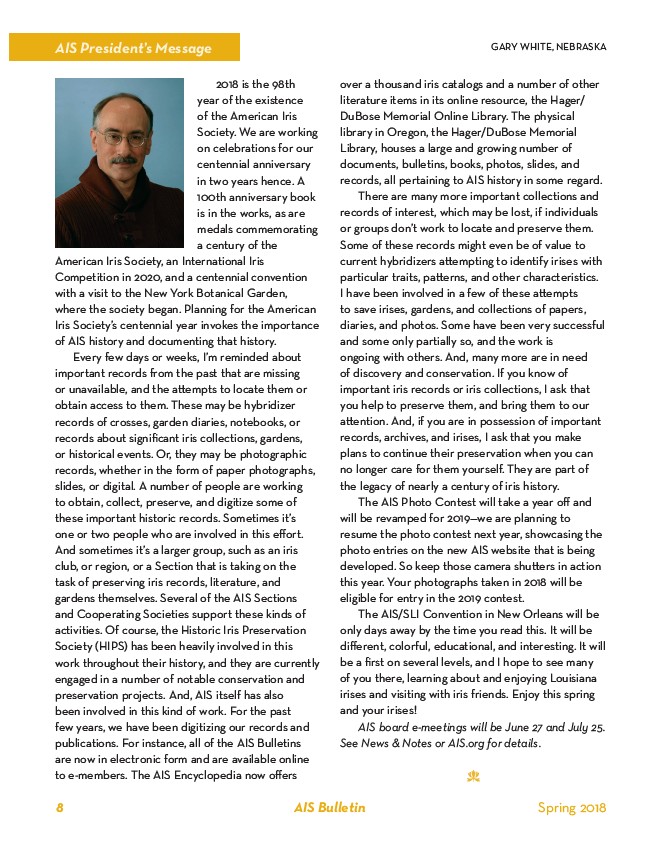
AIS President’s Message GARY WHITE, NEBRASKA
2018 is the 98th
year of the existence
of the American Iris
Society. We are working
on celebrations for our
centennial anniversary
in two years hence. A
100th anniversary book
is in the works, as are
medals commemorating
a century of the
American Iris Society, an International Iris
Competition in 2020, and a centennial convention
with a visit to the New York Botanical Garden,
where the society began. Planning for the American
Iris Society’s centennial year invokes the importance
of AIS history and documenting that history.
Every few days or weeks, I’m reminded about
important records from the past that are missing
or unavailable, and the attempts to locate them or
obtain access to them. These may be hybridizer
records of crosses, garden diaries, notebooks, or
records about significant iris collections, gardens,
or historical events. Or, they may be photographic
records, whether in the form of paper photographs,
slides, or digital. A number of people are working
to obtain, collect, preserve, and digitize some of
these important historic records. Sometimes it’s
one or two people who are involved in this effort.
And sometimes it’s a larger group, such as an iris
club, or region, or a Section that is taking on the
task of preserving iris records, literature, and
gardens themselves. Several of the AIS Sections
and Cooperating Societies support these kinds of
activities. Of course, the Historic Iris Preservation
Society (HIPS) has been heavily involved in this
work throughout their history, and they are currently
engaged in a number of notable conservation and
preservation projects. And, AIS itself has also
been involved in this kind of work. For the past
few years, we have been digitizing our records and
publications. For instance, all of the AIS Bulletins
are now in electronic form and are available online
to e-members. The AIS Encyclopedia now offers
over a thousand iris catalogs and a number of other
literature items in its online resource, the Hager/
DuBose Memorial Online Library. The physical
library in Oregon, the Hager/DuBose Memorial
Library, houses a large and growing number of
documents, bulletins, books, photos, slides, and
records, all pertaining to AIS history in some regard.
There are many more important collections and
records of interest, which may be lost, if individuals
or groups don’t work to locate and preserve them.
Some of these records might even be of value to
current hybridizers attempting to identify irises with
particular traits, patterns, and other characteristics.
I have been involved in a few of these attempts
to save irises, gardens, and collections of papers,
diaries, and photos. Some have been very successful
and some only partially so, and the work is
ongoing with others. And, many more are in need
of discovery and conservation. If you know of
important iris records or iris collections, I ask that
you help to preserve them, and bring them to our
attention. And, if you are in possession of important
records, archives, and irises, I ask that you make
plans to continue their preservation when you can
no longer care for them yourself. They are part of
the legacy of nearly a century of iris history.
The AIS Photo Contest will take a year off and
will be revamped for 2019—we are planning to
resume the photo contest next year, showcasing the
photo entries on the new AIS website that is being
developed. So keep those camera shutters in action
this year. Your photographs taken in 2018 will be
eligible for entry in the 2019 contest.
The AIS/SLI Convention in New Orleans will be
only days away by the time you read this. It will be
different, colorful, educational, and interesting. It will
be a first on several levels, and I hope to see many
of you there, learning about and enjoying Louisiana
irises and visiting with iris friends. Enjoy this spring
and your irises!
AIS board e-meetings will be June 27 and July 25.
See News & Notes or AIS.org for details.
d
8 AIS Bulletin Spring 2018